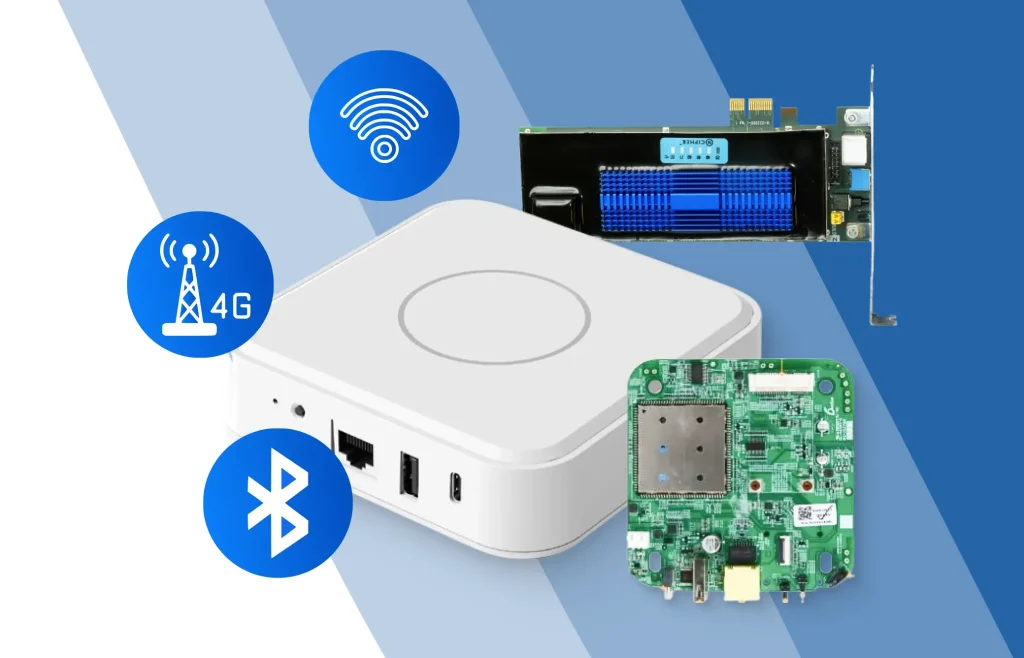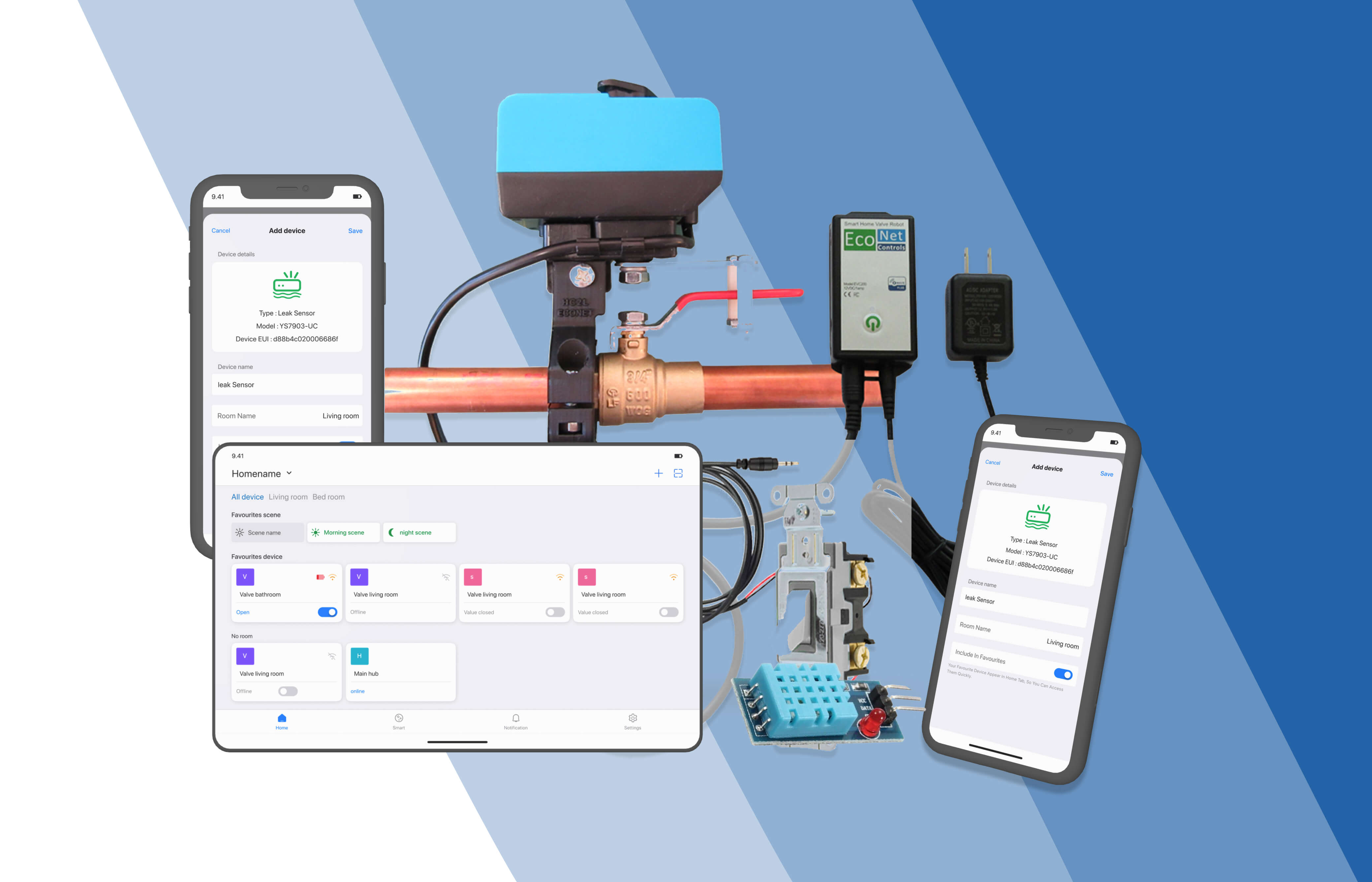IoT Across Industries - Custom IoT Development from Concept to Cloud-Connected Solutions
In today’s fast-evolving digital world, businesses across industries are adopting custom IoT solutions to gain real-time insights, automate operations, and make smarter decisions. From agriculture to automotive, energy, and healthcare, IoT development services are revolutionizing how we live, work, and interact with technology. A top IoT development company can design tailored systems that integrate sensors, software, and data analytics to drive efficiency, cost savings, and innovation.
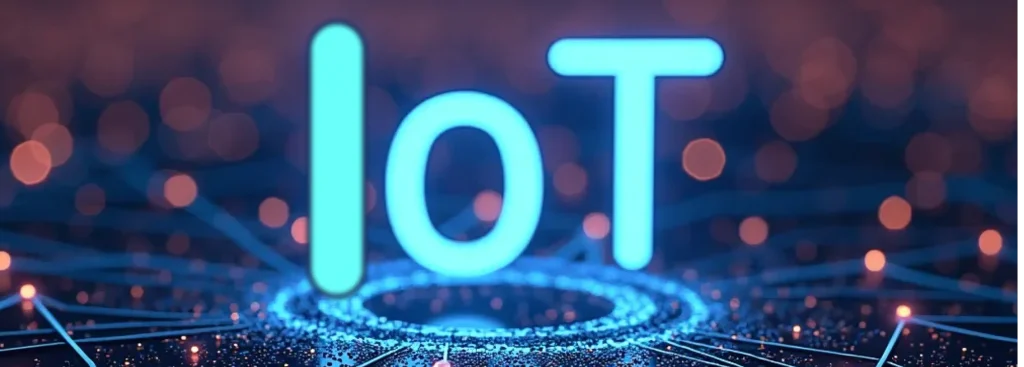
Table of Contents
IoT Development Services for Custom Automation Solutions in Industrial IoT (IIoT) Applications
- The Benefits of Custom IoT Solutions in Healthcare: How IoT is Transforming Patient Care and Operations
IoT Development Services for Custom IoT Solutions in the Automotive Industry
The Benefits of Custom IoT Solutions in Fleet Management: How IoT Can Transform Operations
Transforming Everyday Living with Smart Home Automation by Leading IoT Development Experts
Developing Custom IoT Solutions – Best Practices for Scalable, Secure Innovation
Features of Cloud Platforms for IoT: Powering the Future of Connected Systems
What is IoT?
The Internet of Things (IoT) refers to the network of connected devices embedded with sensors and software that collect, exchange, and act on data. These devices can range from smart thermostats to industrial machines, vehicles, and even medical equipment. Through IoT application development, these devices communicate with cloud systems or edge computing environments to provide real-time feedback, automation, and intelligence for decision-making. Businesses partner with a top IoT app development company to create scalable, secure, and efficient systems that transform their operations. You can also read Harvard Business Review article on How IoT changes everything.
Connect. Monitor. Control. — accelerate your IoT product development with our end-to-end expertise
Industry Wise Applications of IoT
Let’s explore how IoT development services are making a difference across various industries.
IoT Development Services for Custom Automation Solutions in Industrial IoT (IIoT) Applications
Industrial environments are evolving rapidly, and custom IoT automation solutions are at the heart of this transformation. By leveraging Industrial IoT and Automation, manufacturers can adopt smart technologies that enable real-time visibility, predictive maintenance, secure asset tracking, and seamless decision-making. These capabilities reduce operational costs while enhancing efficiency, uptime, and competitiveness in the industrial sector.

What Is Predictive Maintenance, and How Can IoT Enhance Decision-Making in Factory Operations?
Predictive maintenance uses real-time and historical sensor data to anticipate equipment failures before they happen. Unlike reactive or scheduled maintenance approaches, it minimizes downtime and prevents unnecessary repairs.
With IoT automation, manufacturers can continuously monitor factors such as pressure, RPM, oil condition, and vibration trends. When irregularities appear, maintenance teams are alerted in advance. This enhances maintenance scheduling, extends asset lifecycles, and reduces repair expenses—making factory operations more reliable and cost-effective through Industrial Automation and IoT strategies.
What Types of Industrial Assets Can Be Monitored Through IoT-Based Asset Management and Real-Time Asset Tracking Solutions?
A broad range of assets can be managed and tracked with IoT in industrial environments, including:
- Mobile equipment such as forklifts, cranes, and AGVs (automated guided vehicles)
- Stationary machines like CNC machines, conveyor systems, and robotic arms
- Inventory (raw materials, components, and finished products)
- Handheld tools and devices used on the production floor
With IoT-based asset management, sensors and cloud-connected systems provide real-time visibility into location, status, and utilization. These insights help prevent equipment loss, reduce idle time, and improve operational workflow—an essential benefit of Industrial IoT and Automation.
What Role Do IIoT Dashboards and Analytics Play in Improving Decision-Making Within Factory Operations?
Data alone can be overwhelming—IIoT dashboards bridge the gap by turning sensor outputs into actionable intelligence. Integrated into IoT factory automation systems, these dashboards provide:
- Live machine and production line monitoring
- Key performance indicators (KPIs) like energy use, uptime, and throughput
- Predictive alerts based on usage trends and anomalies
- Custom views for different stakeholders, including plant managers and technicians
These tools enable fast, informed decisions and help identify bottlenecks. Tailored analytics ensure that each team member sees relevant data, enhancing Industrial Automation and IoT efficiency.

What Are the Best Practices in IoT Development and Edge Gateway Computing to Secure Connected Industrial Equipment?
Security is foundational to Industrial IoT and Automation. Key best practices include:
- Strong device authentication to validate network access
- End-to-end encryption to safeguard data in transit
- Network segmentation to limit access and reduce risks
- Secure firmware protocols to prevent unauthorized modifications
Additionally, edge gateway computing processes sensitive data locally—minimizing latency, improving responsiveness, and maintaining operational continuity even during network outages. This local-first approach bolsters cybersecurity and supports a resilient IoT factory automation framework.
Tech Stack for IIoT Automation Solutions
Industrial IoT systems use sensors (vibration, temp, pressure), PLCs, edge gateways, and microcontrollers (like STM32, Raspberry Pi CM) for real-time monitoring. Protocols such as Modbus, OPC-UA, MQTT, and Ethernet/IP enable device communication. Edge processing is powered by Embedded Linux or RTOS, with data integrated into cloud platforms like AWS IoT Greengrass, Azure IoT Edge, or private on-prem servers. Dashboards are built using Grafana, Power BI, or Kibana, and security is enforced with TLS encryption, OTA updates, and zero-trust architecture for safe, scalable automation.
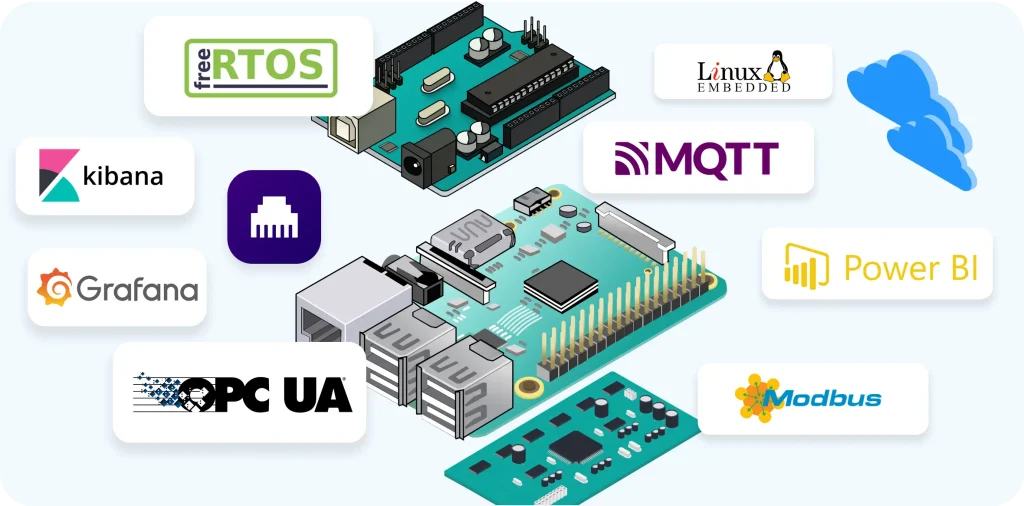
The Benefits of Custom IoT Solutions in Healthcare: How IoT is Transforming Patient Care and Operations
The healthcare industry is evolving rapidly, with IoT playing a pivotal role in digital transformation. Healthcare providers face persistent challenges—rising operational costs, patient data management, equipment tracking, and the need for personalized care.
Custom IoT healthcare solutions offer real-time visibility, data-driven decision-making, and automation across healthcare facilities. Whether it’s a single clinic or a multi-hospital network, these systems integrate seamlessly into existing medical infrastructure, enabling improved patient outcomes, operational efficiency, and scalability.
Real-Time Patient Monitoring and Smart Health Dashboards
For effective healthcare IoT systems, centralized data and control are essential. Smart dashboards provide real-time access to patient vitals and clinical metrics, such as:
- Heart rate and blood pressure monitoring
Oxygen saturation level - Blood glucose tracking
- Patient movement and fall detection
- Environmental monitoring (e.g., temperature and humidity in operating rooms)
These insights enable early intervention, better care coordination, and continuous remote monitoring. Custom dashboards are tailored to each healthcare environment—ensuring fast, informed clinical decisions.

Enhancing Operational Control with Asset and Staff Tracking
Hospital operations rely on the efficient use of both assets and human resources. IoT-enabled asset tracking and geofencing allow healthcare managers to:
- Track medical equipment in real time
- Monitor staff movement for workflow optimization
- Prevent unauthorized access to sensitive areas
- Automate alerts for out-of-bound assets or personnel
This boosts accountability, reduces asset loss, and supports compliance with healthcare regulations and standards.
Improving Patient Safety Through Behavior and Condition Monitoring
- Sleep patterns and movement during hospitalisation
- Changes in posture that could indicate a fall risk
- Mediation adherence through smart pill dispensers
- Signs of distress in elderly or chronic care patients
Revolutionizing Clinical Operations with Smart Medical Devices and Telematics
IoT-integrated medical devices and telematics empower healthcare providers with a deeper understanding of equipment usage and patient interaction. Custom solutions can:
- Automate maintenance scheduling for critical devices
- Monitor usage rates to allocate resources effectively
- Track sterilization cycles and environmental conditions
- Integrate with EMRs (Electronic Medical Records) and telehealth systems
With reliable, automated data flow from IoT devices, healthcare operations become more predictable, compliant, and responsive—enhancing patient satisfaction and reducing overhead.
Ensuring Interoperability and Security with Edge Computing and IoT Standards
Healthcare IoT environments often include third-party devices and platforms, raising security and compatibility challenges. A secure custom solution addresses these concerns by:
- Authenticating all medical IoT devices with secure identity management
- Encrypting patient data in transit and at rest
- Performing real-time anomaly detection at the edge
- Supporting HL7, FHIR, and DICOM standards for interoperability
Edge computing reduces latency and ensures sensitive data stays within local networks when necessary—crucial for compliance with HIPAA and other data protection regulations.
Tech Stack for Healthcare IoT Solutions
Custom IoT healthcare systems are built on medical-grade sensors, wearables, and BLE devices. Connectivity is enabled via Wi-Fi, 4G/5G, and LPWAN protocols (e.g., Zigbee, LoRa). Data is processed using edge gateways and cloud services like AWS HealthLake, Azure Health Data Services, or Google Cloud Healthcare API. Real-time analytics dashboards are built with Node.js, React, and MQTT brokers. Security is maintained using TLS, secure boot, blockchain for data integrity, and OTA updates for continuous improvement.
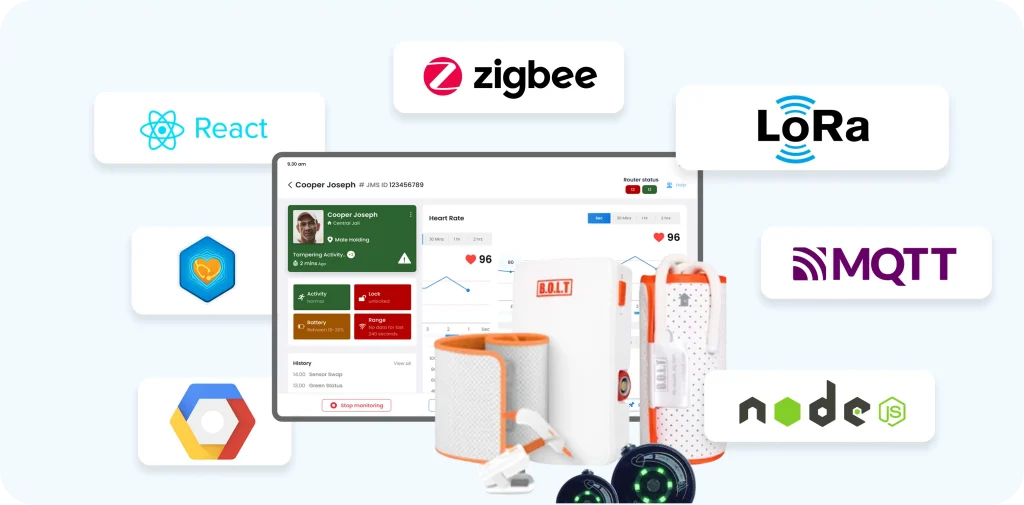
Smart Farming with Custom IoT Solutions in Agriculture
Farming is undergoing a major transformation with the rise of custom IoT solutions for smart agriculture. IoT Dashboard in agriculture that monitors every aspect of a farm—from soil moisture and crop health to livestock tracking and weather forecasting. These systems provide farmers with real-time insights, enabling data-driven decision-making, reducing manual work, and significantly improving efficiency and yields. This marks the beginning of true precision agriculture, where every action is backed by real-time data and automation powered by IoT in agriculture.
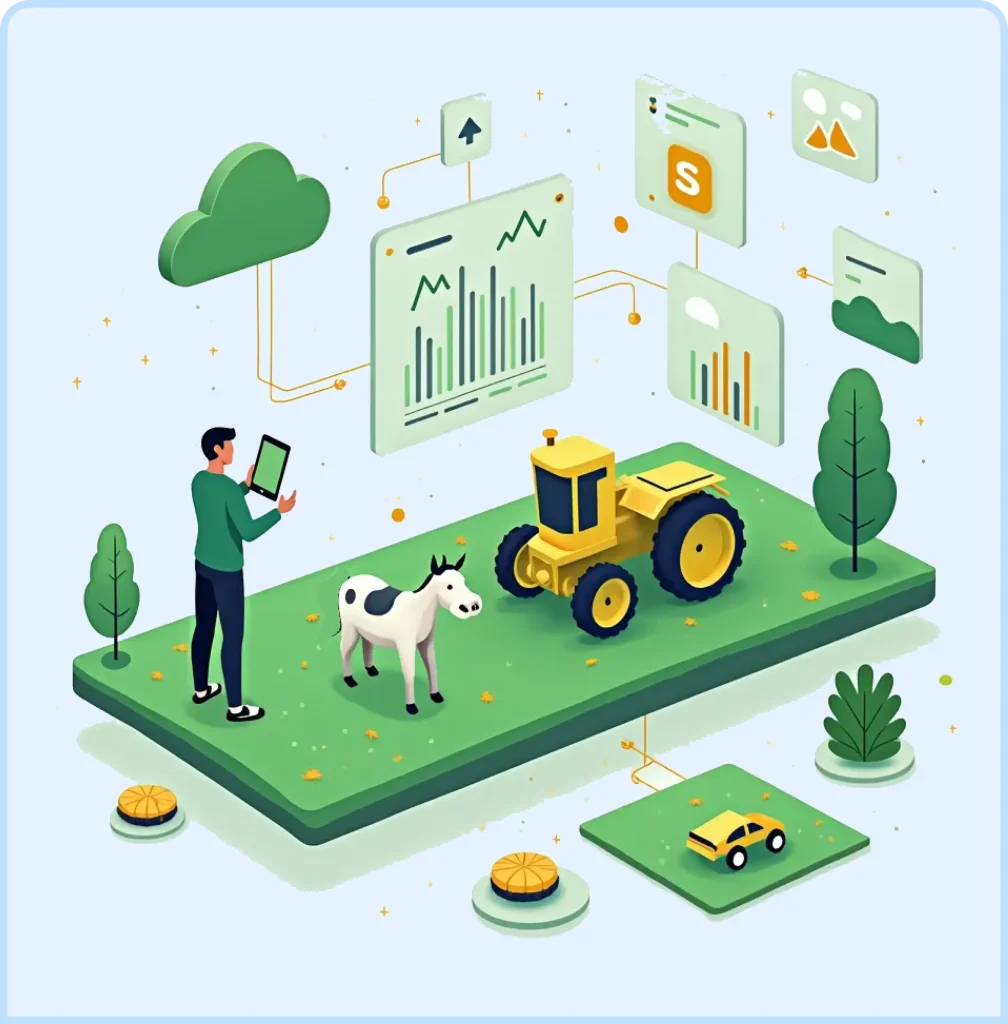
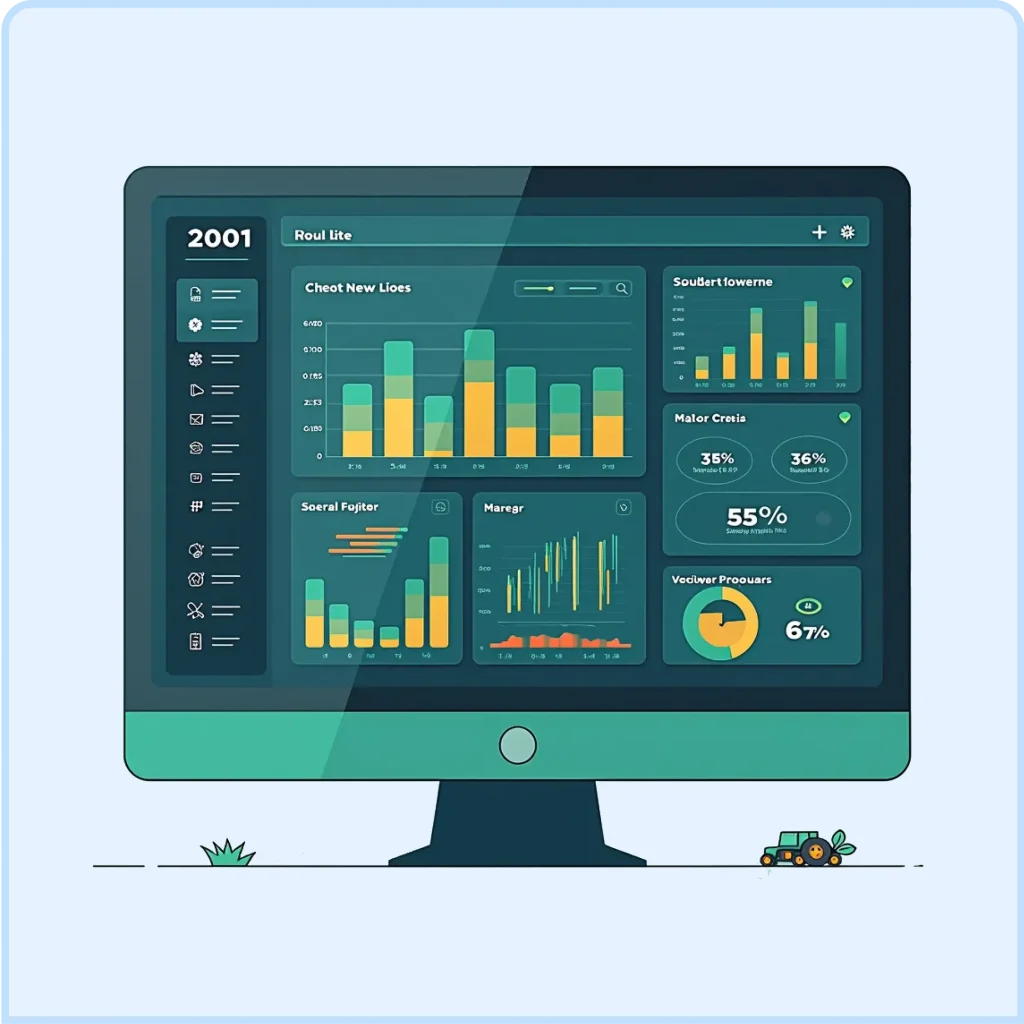
What is Smart Irrigation, and How Can an IoT Development Company Enhance It?
Smart irrigation systems are a game-changer in modern farming. Instead of relying on manual watering schedules, this technology uses IoT sensors in agriculture to measure real-time data like soil moisture, humidity, and weather forecasts. A top IoT app development company can build intelligent systems that automate irrigation based on these inputs. The result? Crops get exactly the water they need—no more, no less.
With real-time monitoring, intelligent automation, and data-driven water management, IoT in smart agriculture helps reduce water waste, increase crop yields, and support sustainability goals. IoT in agriculture manages irrigation remotely through mobile dashboards, helping farmers optimize every drop of water. – Check out our IoT-powered Smart Watering Solution designed to boost farm efficiency and optimize irrigation with real-time data.
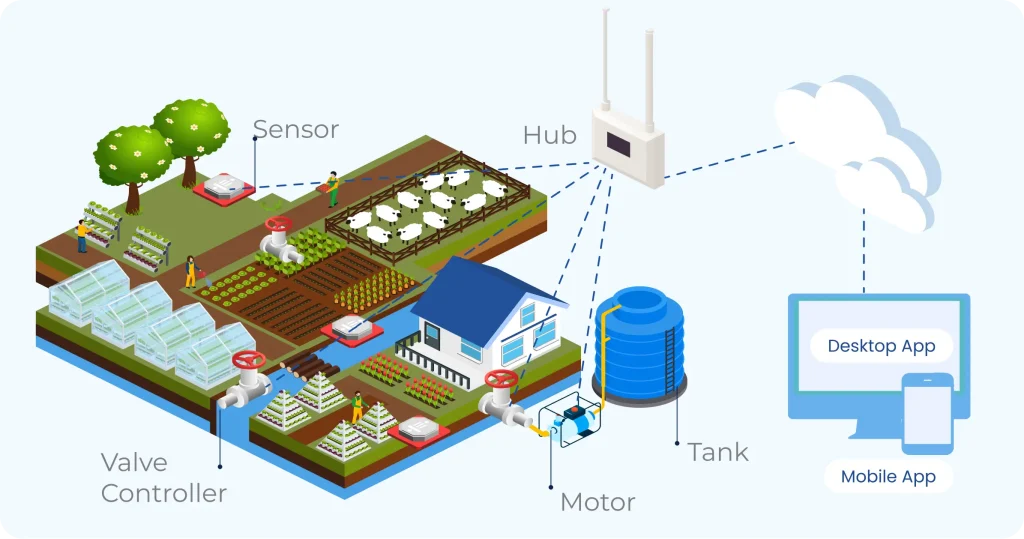
What Are the Cost-Saving Benefits of Using IoT in Farming, and How Can an IoT Development Company Help Maximize Efficiency and Reduce Resource Waste?
Farming can be resource-intensive, but IoT brings a smarter, leaner approach. With custom IoT solutions in agriculture, farmers can automate operations such as irrigation, fertilization, pest control, and even machinery maintenance. This minimizes the need for constant human supervision and reduces the overuse of costly inputs like water and chemicals.
An experienced IoT development company designs solutions that help farmers track energy usage, prevent equipment downtime, and make informed decisions in real time. The cost savings are substantial—lower input expenses, reduced labor costs, and improved harvest quality and output. Over time, the return on investment in IoT in agriculture becomes very clear, both in financial and environmental terms.
What Are the Advantages of Data-Driven Farming Through IoT, and How Can IoT Application Development Empower Smarter, More Efficient Agricultural Practices?
Traditional farming often relies on intuition and past experience. But data-driven farming replaces guesswork with reliable metrics. With IoT applications in agriculture and intuitive analytics dashboards, farmers can monitor key indicators such as soil health, crop growth, humidity, and pest activity.
A custom IoT solution developed by a top IoT app development company enables farmers to adjust planting cycles, select optimal harvest times, and react quickly to environmental threats. It also enhances long-term strategic planning, supporting better risk management and resource allocation. With decisions rooted in data, farms become more productive, sustainable, and profitable.
What Are the Biggest Challenges in Firmware Development and Deploying IoT Solutions for Over-the-Air Updates in Rural Areas for Smart Farming?
While the benefits of smart farming using IoT in agriculture are compelling, deployment in rural areas presents unique technical hurdles. A major challenge is developing firmware development solutions that support over-the-air (OTA) updates. In many remote regions, internet connectivity is unstable, making it tough to roll out updates or apply security patches.
A reliable IoT company must design lightweight firmware that performs secure updates even with intermittent connections. This involves expert-level software engineering, robust security protocols, and offline-capable architecture to ensure that devices remain functional and secure—no matter how remote the location.
How Can Edge Gateway Computing Be Leveraged Through IoT Development Services to Enhance Smart Farming Applications?
In areas with limited or spotty internet, edge gateway computing is essential. Rather than sending data to the cloud for processing, this approach allows data to be analyzed locally on the farm. The benefit? Faster decision-making, reduced bandwidth usage, and continued operation even when offline.
Using edge gateway solutions, a top IoT development company empowers farmers with instant alerts and automation triggers. Whether it’s detecting a sharp temperature drop or a sudden need for irrigation, edge-powered IoT in smart agriculture ensures real-time responsiveness. This not only makes farming smarter but also more resilient and scalable across diverse agricultural environments.
Tech Stack for Smart Farming IoT Solutions
Smart farming solutions typically use a mix of robust hardware and scalable software. Common components include soil sensors, weather stations, GPS trackers, and LoRaWAN/NB-IoT modules for connectivity. Microcontrollers like ESP32 or STM32 pair with edge gateways for local processing using FreeRTOS or Embedded Linux. Data is transmitted via MQTT or BLE and processed on AWS IoT, Azure IoT Hub, or Google Cloud IoT. Grafana or ThingsBoard powers real-time dashboards, while TLS encryption, OTA updates, and secure bootloaders ensure safety and reliability across rural deployments.
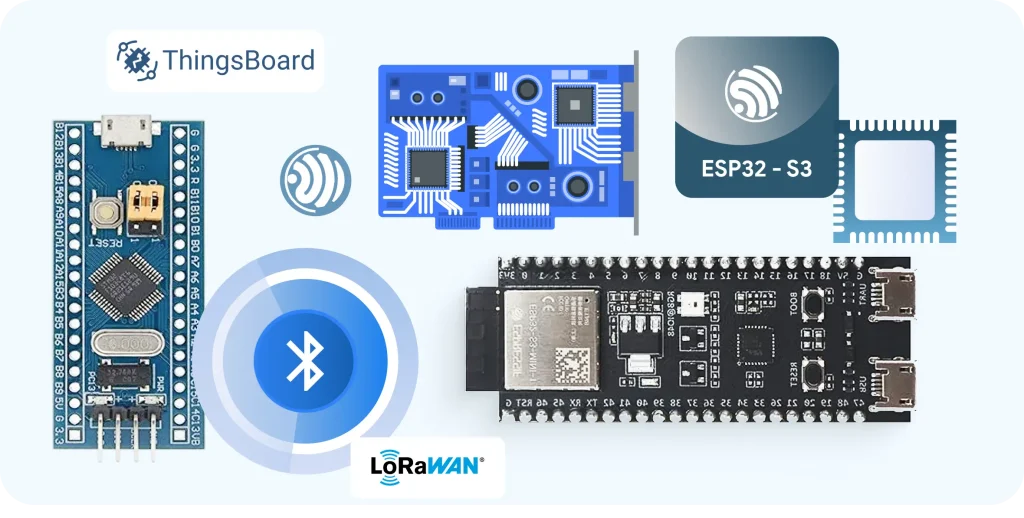
Download our Smart Farming Product Brochure here
IoT Development Services for Custom IoT Solutions in the Automotive Industry
The IoT in the automotive industry is accelerating innovation like never before. From connected cars to autonomous vehicles, custom IoT solutions are driving smarter, safer, and more efficient mobility experiences. These systems connect vehicles, drivers, infrastructure, and cloud platforms in real time—empowering everything from predictive diagnostics to intelligent navigation and remote updates.
How IoT Solutions and Sensor Technology Are Powering the Future of Connected and Autonomous Vehicles
Modern vehicles are equipped with a web of embedded IoT sensors in automotive systems—such as LiDAR, radar, ultrasonic sensors, and smart cameras—that capture real-time data on surroundings, road conditions, and internal systems.
Through IoT applications in automotive industry, this data is processed using AI and edge computing to enable advanced features like:
- Collision avoidance
- Lane-keeping assistance
- Self-parking systems
- Adaptive cruise control
These connected and autonomous capabilities not only improve safety but also enhance convenience and responsiveness—pushing the boundaries of what’s possible in modern mobility.
Enhancing Vehicle Performance with IoT and Real-Time Diagnostics
- Reduce maintenance costs
- Avoid unplanned breakdowns
- Extend vehicle lifespan
- Improve fuel efficiency
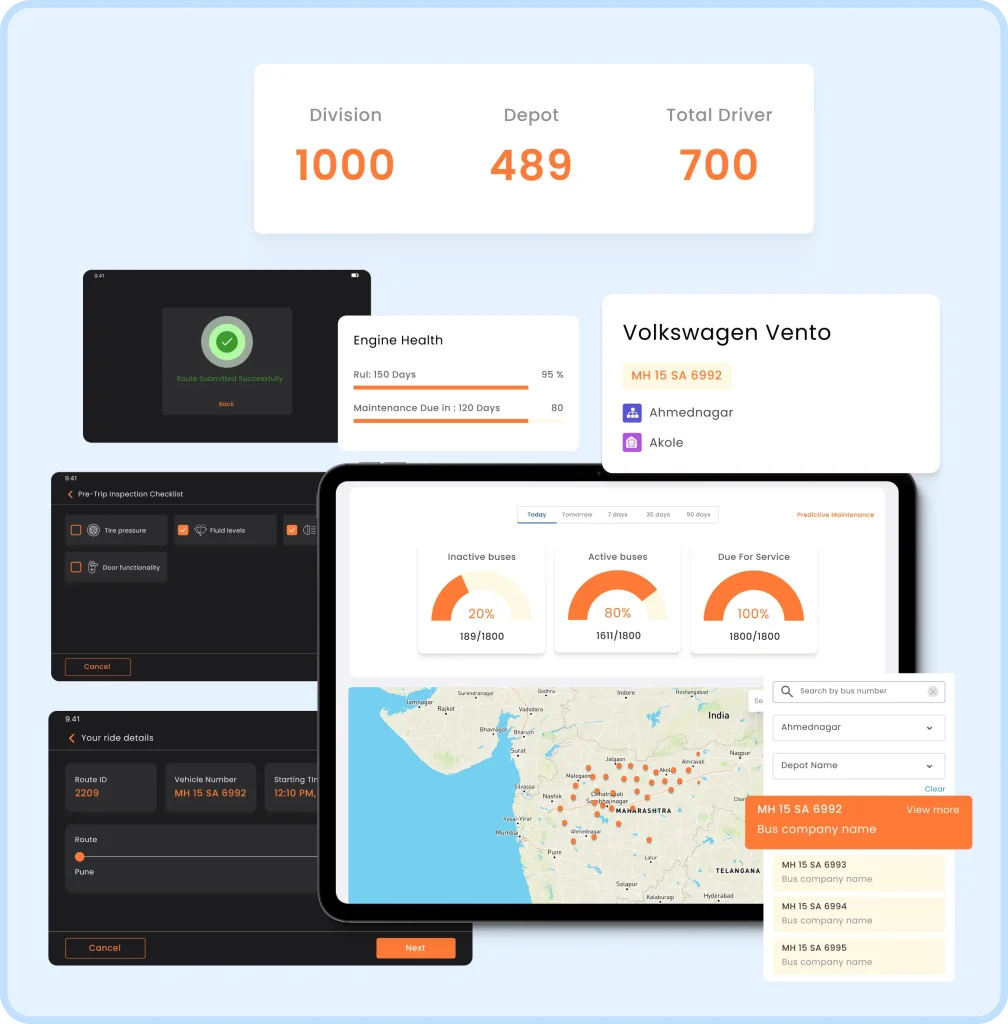
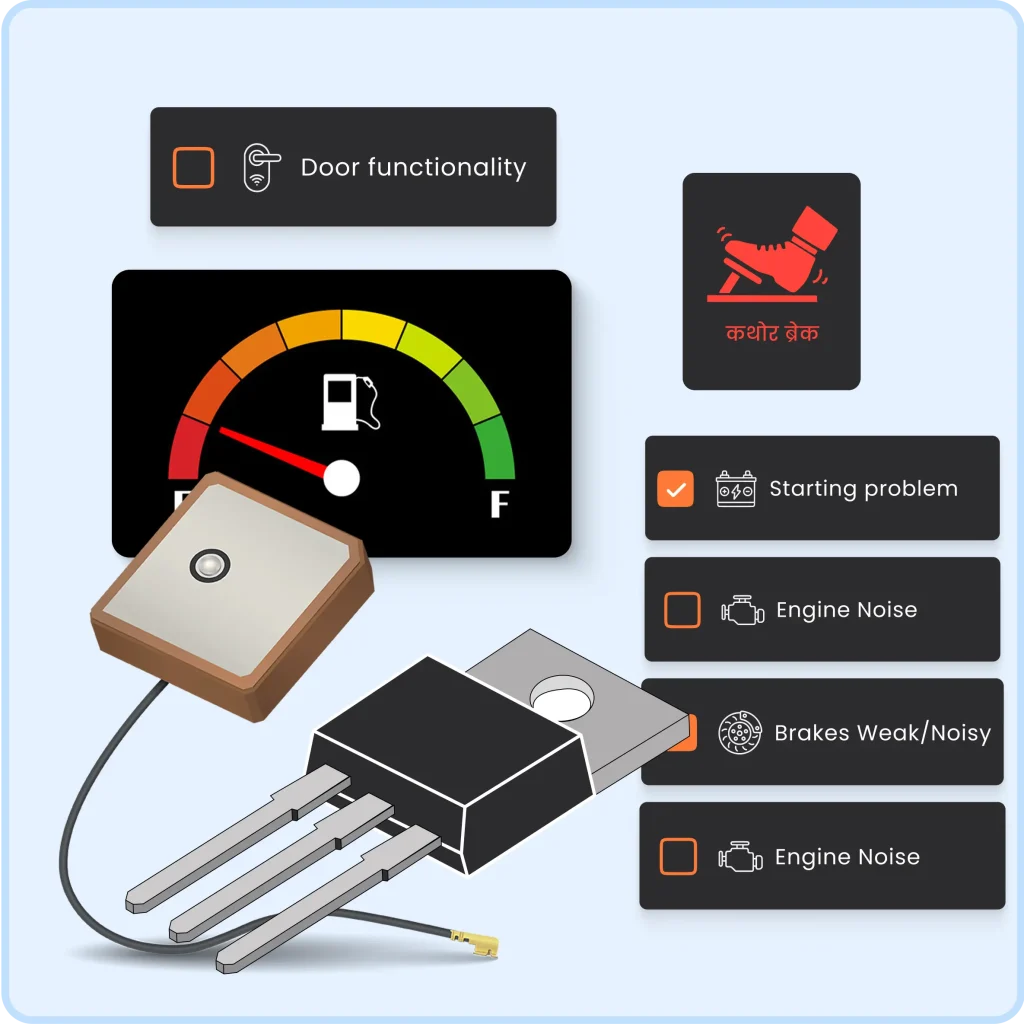
The Role of Embedded IoT Sensors in Automotive Intelligence and Smart Connectivity
Embedded IoT sensors in automotive systems collect and relay data about driver behavior, vehicle conditions, and environmental factors. When combined with smart dashboards and cloud analytics, this enables:
- Personalized driving feedback
- Adaptive route planning
- Fuel efficiency optimization
- Emissions monitoring
This seamless ecosystem of connected devices enhances user experience, supports sustainability, and introduces a new era of automotive intelligence powered by IoT.
How OTA Technology and Connected Devices Are Revolutionizing Smart Vehicle Maintenance
Over-the-Air (OTA) updates have changed the way vehicles stay current and secure. No longer dependent on dealership visits, vehicles can now receive remote software upgrades for infotainment systems, engine management, safety features, and navigation maps.
With IoT in automotive industry, OTA capabilities bring:
- Instant feature upgrades
- Security patching
- Remote diagnostics
- Edge-computing-enabled updates for low-connectivity zones
Combined with real-time monitoring, OTA solutions make smart maintenance seamless, efficient, and scalable for both consumers and fleet operators.
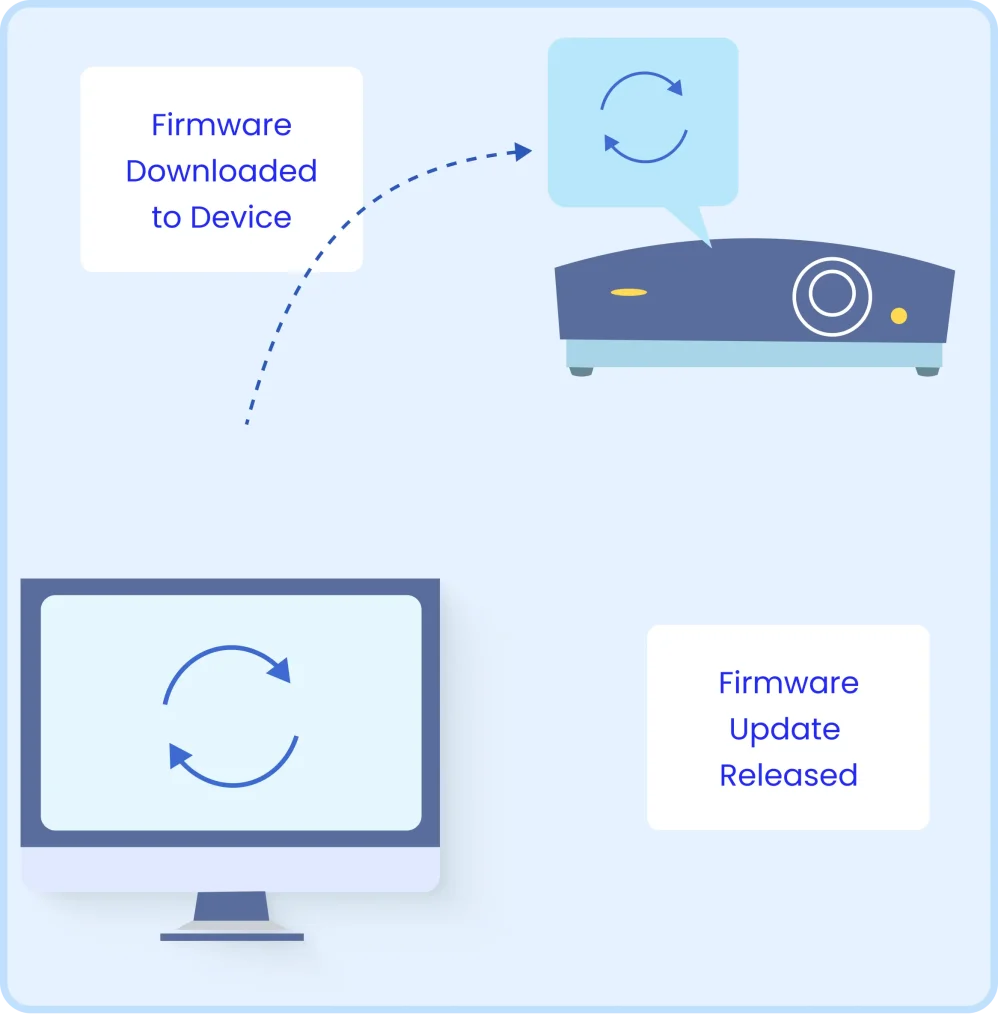
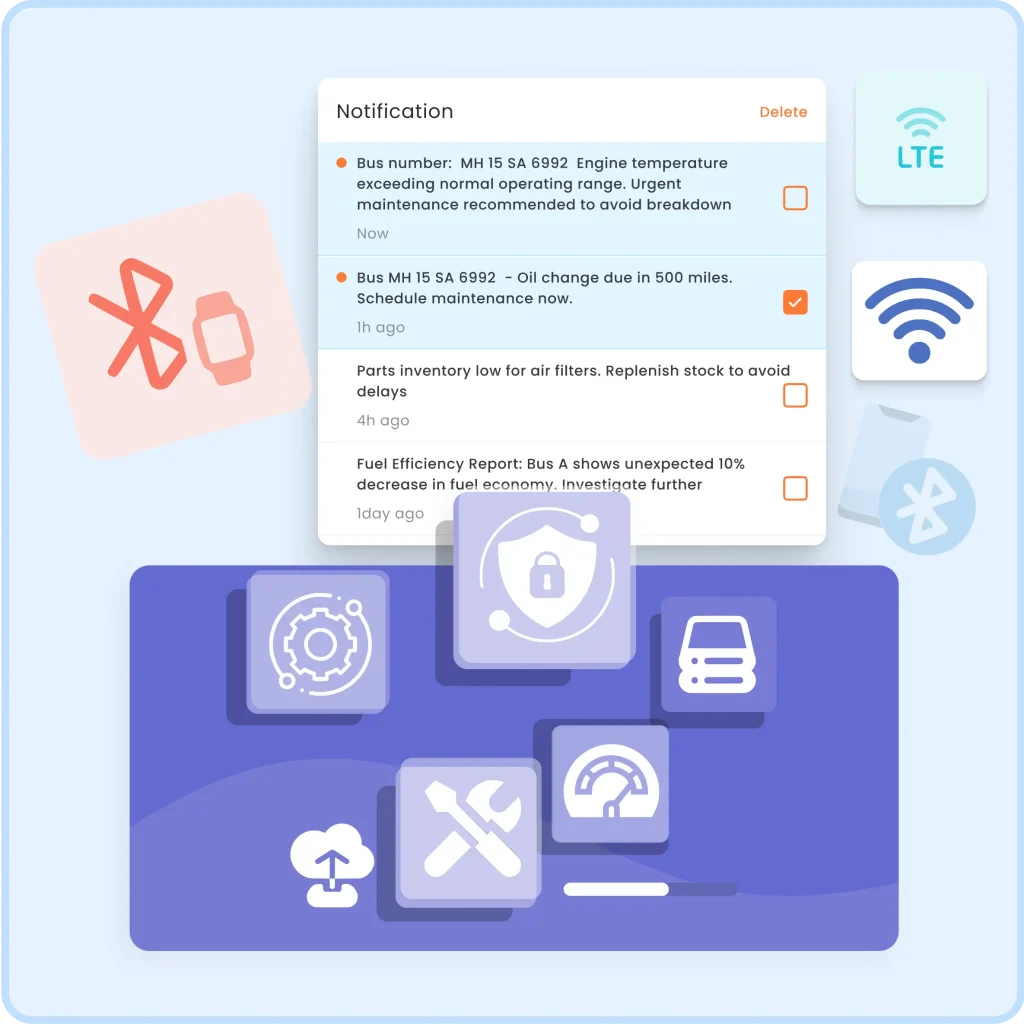
Why Custom IoT Solutions Are Essential for the Automotive Industry
A successful automotive IoT deployment requires:
- Custom end-to-end architecture tailored for connected, autonomous, and electric vehicles
- Secure and scalable platforms for diagnostics, tracking, and firmware updates
- Expert integration of embedded IoT sensors in automotive components
- Real-time analytics for OEMs, fleet managers, and service centers
- OTA infrastructure and edge computing for remote update delivery
By leveraging these capabilities, manufacturers and mobility providers can future-proof operations, enhance vehicle intelligence, and deliver next-gen driving experiences.
Technology Overview for Automotive IoT Solutions
Automotive IoT solutions leverage embedded sensors (LiDAR, radar, GPS, CAN bus), edge processors (NVIDIA Jetson, NXP i.MX), and communication protocols like CAN, MQTT, V2X, and 5G for high-speed data exchange. Edge AI enables real-time decisions, while cloud integration via AWS IoT Core, Azure IoT Hub, or Google Cloud AutoML supports analytics, OTA updates, and predictive diagnostics. Secure firmware, OTA frameworks, and compliance with ISO 26262 and AUTOSAR ensure safety, scalability, and seamless connected mobility.
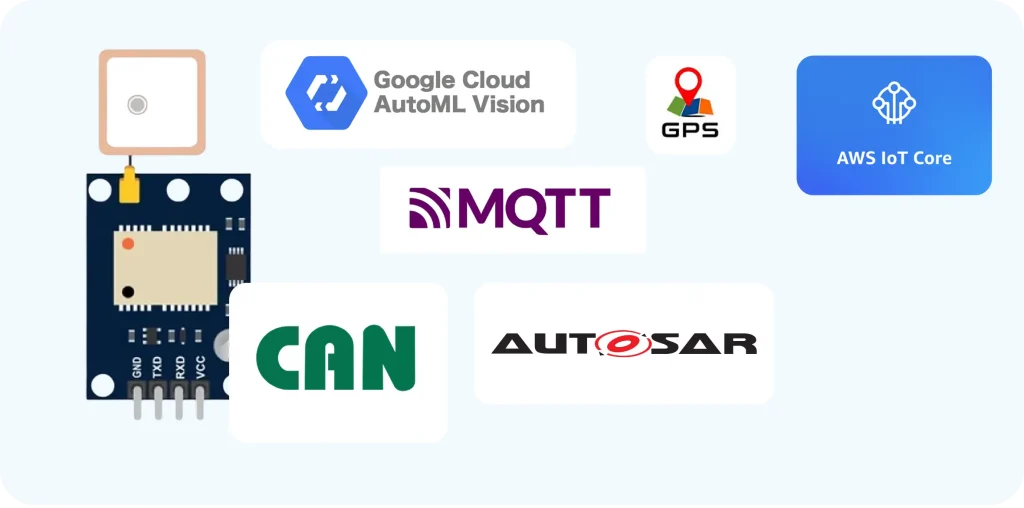
The Benefits of Custom IoT Solutions in Fleet Management: How IoT Can Transform Operation
The logistics and transportation industry is undergoing rapid transformation, driven by advancements in IoT fleet management. Fleet operators face ongoing challenges—rising fuel costs, compliance pressure, route inefficiencies, and driver safety concerns.
With custom IoT fleet management solutions, businesses gain real-time visibility, data-driven decision-making, and automation across their entire fleet. These systems seamlessly integrate with existing infrastructure, whether managing a local delivery fleet or a global transportation network, unlocking new levels of efficiency, safety, and scalability.
Real-Time Fleet Tracking and Monitoring with IoT Dashboards
Effective IoT-based fleet and equipment management solutions require centralized data and control—and that’s where custom dashboards come in. Fleet managers gain real-time access to critical metrics such as:
- Live vehicle tracking
- Fuel consumption
- Engine health and diagnostics
- Tire pressure monitoring
- Cargo status and environmental conditions
These insights enable proactive responses, faster decision-making, and predictive maintenance planning. Designed for usability and tailored to specific fleet needs, fleet management IoT device data streams into a single interface—creating more efficient and agile operations.
Enhancing Operational Control with Geofencing Capabilities
Geofencing is one of the most practical and powerful features of modern IoT fleet management. By defining digital zones, managers can automate alerts when vehicles enter or exit designated areas. This technology supports:
- Route compliance
- Time management
- Idle time control in restricted zones
- Asset security in high-risk area
Monitoring Driver Behavior for Safer, More Efficient Fleets
Driver behavior directly impacts fuel efficiency, safety, and fleet wear and tear. With fleet management IoT device implementation, businesses can monitor:
- Speeding and aggressive driving
- Harsh braking or sharp turns
- Excessive idling
- Route deviations
These data points are analyzed in real time to help managers identify patterns, deliver training, and reward safe driving. This leads to lower insurance premiums, reduced accident risks, and a culture of safety across the fleet. Read one of our solutions for Driver behavior analysis.
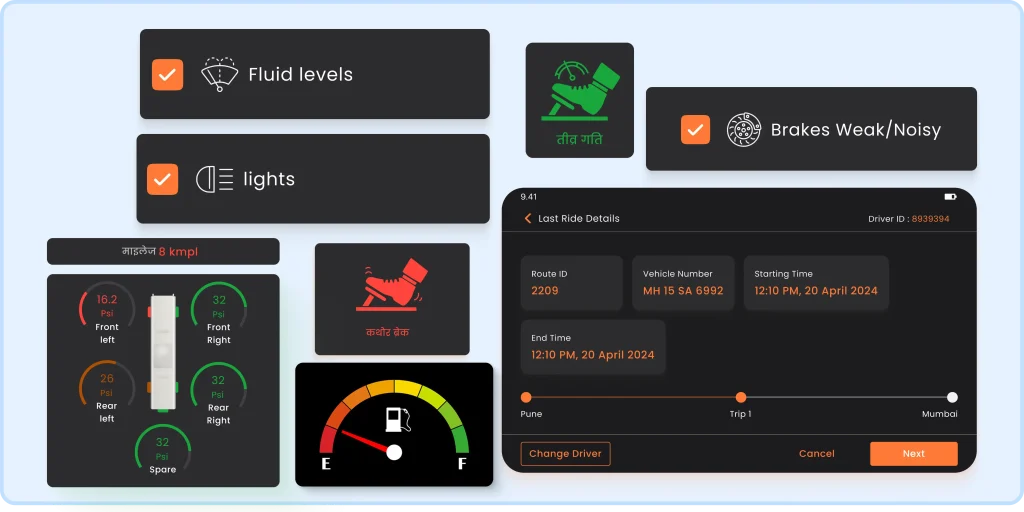
Revolutionizing Fleet Operations with Telematics and IoT
Telematics, when combined with IoT, becomes a powerful tool for optimizing every aspect of vehicle performance. A custom IoT-based fleet and equipment management solution leverages telematics to:
- Improve route planning and fuel efficiency
- Reduce vehicle downtime through predictive maintenance
- Track driver hours and ensure compliance
- Automate resource planning and reporting
With data collected from onboard fleet management IoT devices, logistics operations become more predictable, timely, and cost-effective—enhancing customer satisfaction and profitability.
Securing Third-Party Integrations with Edge Computing and IoT Security Best Practices
Many fleets incorporate third-party hardware and platforms, which introduces potential vulnerabilities. Standardization challenges, data security, and firmware integrity are key concerns. A secure IoT fleet management solution addresses this by:
- Validating device authentication protocols
- Ensuring firmware updates are protected from tampering
- Segmenting networks to isolate sensitive operations
- Leveraging edge computing to process data locally—limiting cloud exposure
Technical Infrastructure for IoT Fleet Management Solutions
Custom IoT fleet systems are built on a stack that includes GPS modules, OBD-II sensors, and CAN bus integrations for vehicle diagnostics. Communication is enabled through 4G/5G, NB-IoT, and LPWAN protocols (like LoRaWAN). Telematics data is processed using edge gateways and pushed to cloud platforms like AWS IoT FleetWise, Azure IoT Central, or Google Cloud IoT. Real-time dashboards are built using Node.js, React, and MQTT brokers, while security is ensured with TLS encryption, secure bootloaders, and OTA update frameworks.
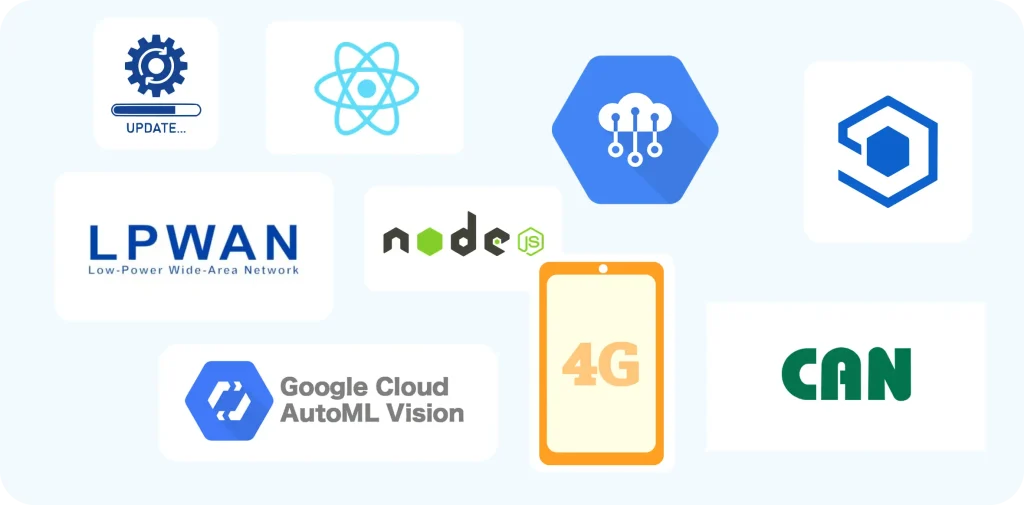
Download our IoT Project Portfolio here
Transforming Everyday Living with Smart Home Automation by Leading IoT Development Experts
Smart home automation is redefining comfort, convenience, and control in modern living. Imagine waking up to a home that knows your preferred lighting, adjusts the temperature automatically, and keeps your family safe with intelligent, always-on security. These experiences are made possible through custom IoT solutions developed by top-tier IoT development companies.
By integrating smart home automation devices like lights, thermostats, voice assistants, security systems, and appliances into one connected ecosystem, homeowners gain personalized control and an enhanced lifestyle tailored to their daily routines.
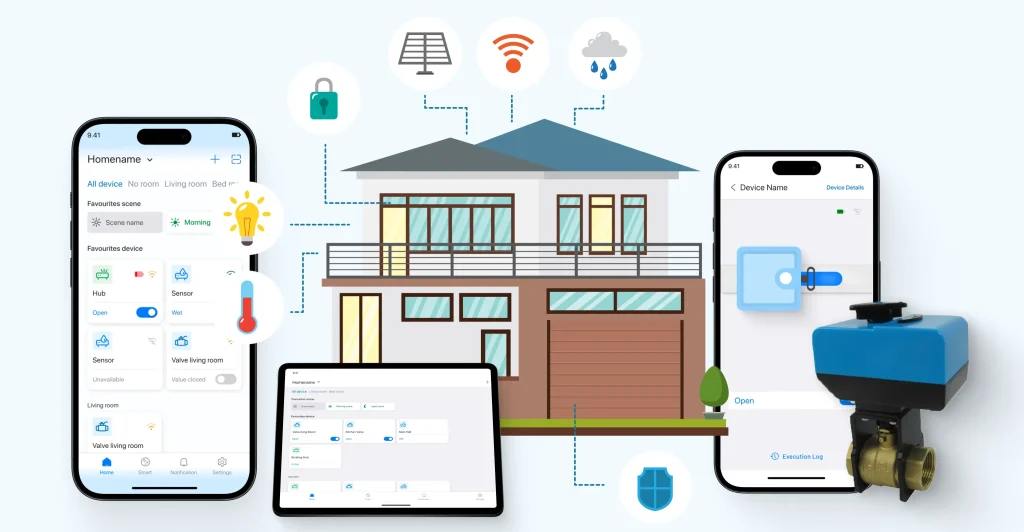
Why Smart Lighting Systems Are Essential in Smart Home Technology
Lighting does more than illuminate—it sets the tone for your day. With smart home technology, lighting adapts to your habits and environment. Motion-activated lights turn on as you walk into a room, ambient lighting adjusts based on natural sunlight, and all settings are accessible from your phone or voice assistant.
With custom-built IoT solutions, smart lighting systems become intuitive and energy-efficient, syncing with your schedule to enhance comfort, safety, and mood. These systems are vital components of the best smart home system, offering not just automation, but real-time adaptability to your lifestyle.
Voice Control: The Core of a Seamless Smart Home Experience
Voice assistants like Alexa, Google Assistant, and Siri are now integral to smart home automation devices. With expert IoT development services, your voice becomes a powerful tool to control everything—lighting, locks, music, thermostat, and even security—hands-free.
Voice control enhances home accessibility, especially for seniors or those with mobility challenges. In a kid-friendly smart home, simple commands make interaction with technology safe and fun while ensuring secure access through parental controls.
The Evolution of Smart Appliances Through IoT Services
- Maintenance alerts
- Usage optimization
- Voice and app control
- Energy-saving schedules
Centralized Control with IoT Monitoring Dashboards in Smart Homes
Managing dozens of connected devices can be overwhelming without a centralized IoT device management dashboard. A unified dashboard empowers users to monitor and control their entire smart home from one location—whether via app, voice, or touchscreen.
The IoT monitoring dashboard in smart home settings provides real-time insights on:
- Device status
- Energy usage
- Environmental data (temperature, humidity)
- Alerts and security notifications
This level of visibility streamlines home management, enhances security, and ensures every device performs as intended—all through one intuitive interface.
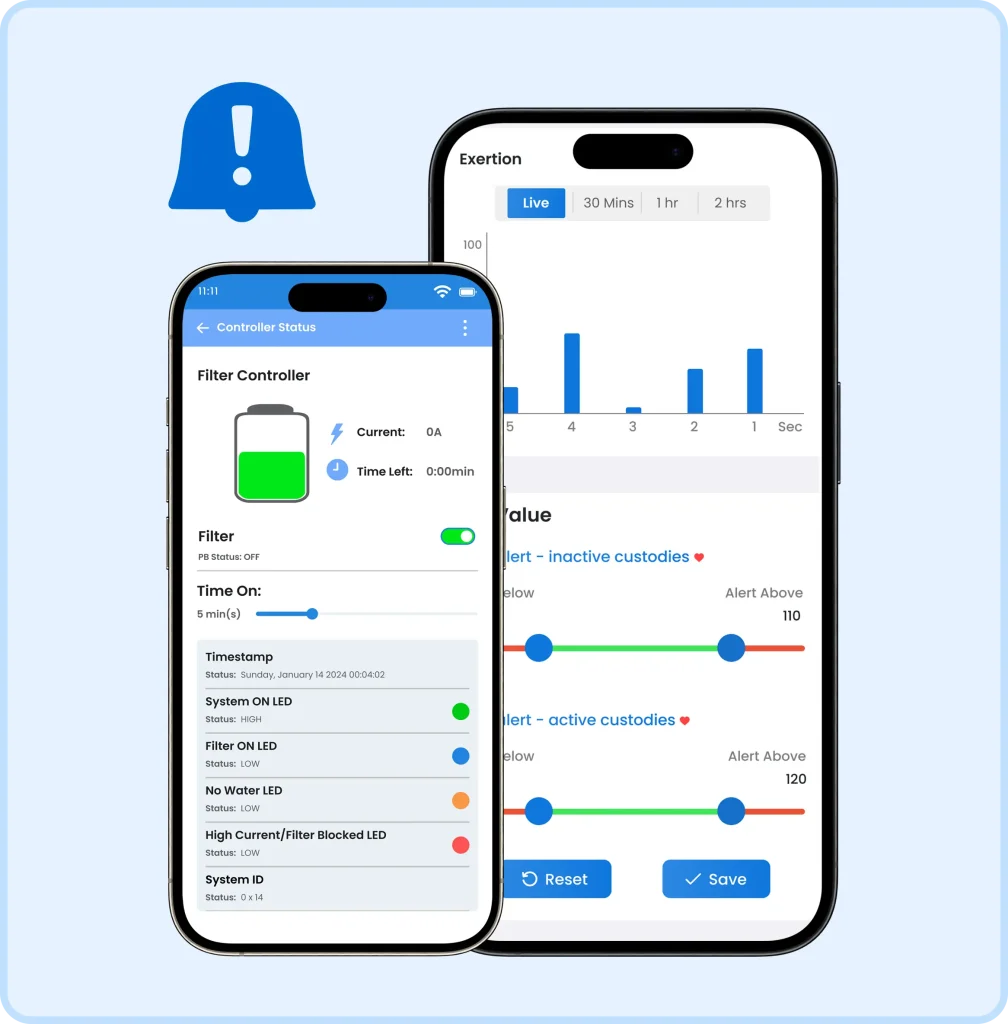

Strengthening Smart Home Security with Edge Gateway Computing and Secure IoT Development
While smart homes offer remarkable convenience, they also pose new security challenges. Smart home security systems must defend against cyberattacks and unauthorized access. That’s where edge gateway computing comes into play.
By processing data locally, edge gateways reduce cloud dependency and filter sensitive data before it’s transmitted online. This approach:
- Enhances device-to-device encryption
- Reduces latency
- Blocks malicious access
- Keeps your smart home security robust and responsive
Secure firmware updates, authentication protocols, and encrypted data channels are essential features built into the architecture by leading IoT developers, keeping your family and devices protected at all times.
Technical Infrastructure for IoT Fleet Management Solutions
Smart home automation systems combine connected hardware with scalable software platforms. Key components include Zigbee, Z-Wave, Wi-Fi, and Bluetooth-enabled devices like smart lights, thermostats, locks, and appliances. Microcontrollers such as ESP32, Raspberry Pi, or STM32 run real-time OS like FreeRTOS or lightweight Linux. Data flows via MQTT, CoAP, or HTTP protocols and integrates with platforms like AWS IoT Core, Google Cloud IoT, or Apple HomeKit. Dashboards and mobile control interfaces are built using React Native or Flutter, while edge gateways process local data and enable fast automation. Security features include end-to-end encryption, OAuth 2.0, secure firmware updates, and role-based access controls to ensure user safety and data privacy.
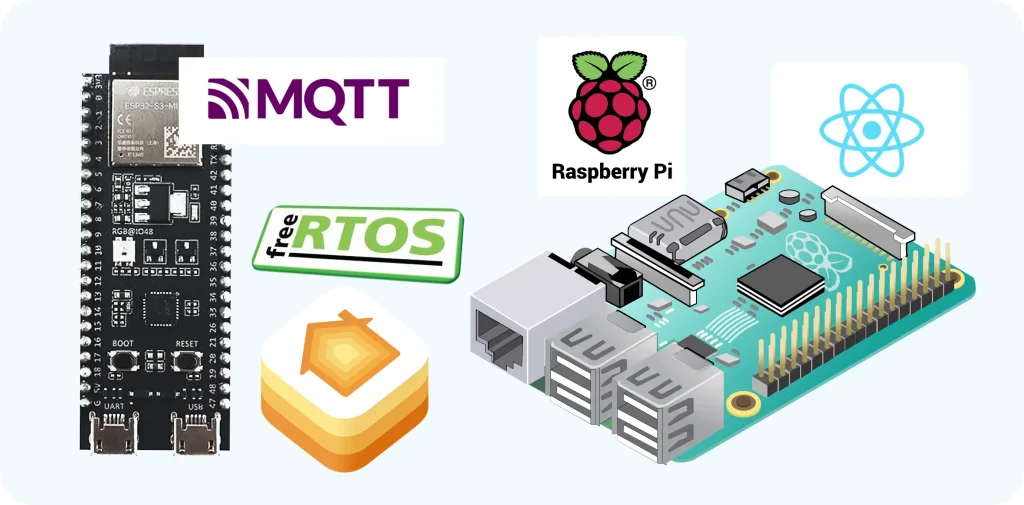
Developing Custom IoT Solutions – Best Practices for Scalable, Secure Innovation
Creating impactful custom IoT solutions requires much more than just connecting devices—it’s about engineering reliable, scalable, and secure ecosystems that solve real-world business challenges. A leading software vendor for custom IoT development approaches each project with a blend of technical expertise, domain understanding, and forward-thinking strategy to deliver long-term value.
Define the Business Problem Before Building the Tech
The foundation of any successful IoT project begins with a deep understanding of the client’s industry-specific pain points. Whether it’s improving predictive maintenance in manufacturing or enabling remote diagnostics in healthcare, custom IoT development must be tailored to solve a particular problem with measurable impact.
Strategic planning ensures that all technology choices—hardware, communication protocols, cloud services—align with business goals and offer a path toward ROI.
Select the Right Hardware and Protocol Stack
Choosing the appropriate sensors, microcontrollers, edge gateways, and connectivity protocols is a critical step. Factors like energy consumption, environment, latency, and range influence the selection between MQTT, LoRaWAN, BLE, Zigbee, or NB-IoT.
A top-tier software vendor for custom IoT development will ensure that your architecture is both high-performing and cost-effective, with components selected for long-term viability and easy integration
Firmware Development for Custom IoT Solutions: The Bridge Between Hardware and Software
Firmware development for custom IoT solutions is one of the most critical—and complex—layers in the entire ecosystem. Efficient, secure, and scalable firmware:
- Interfaces directly with sensors and microcontrollers
- Manages data acquisition, filtering, and edge processing
- Enables secure OTA (over-the-air) updates
- Supports fallback and recovery modes
- Handles power management in resource-constrained environments
By investing in high-quality firmware, businesses ensure that their IoT devices are robust, adaptable, and perform reliably in real-world conditions.
Embrace Embedded System Software and the Power of Embedded Linux
Most custom IoT solutions rely on some form of embedded system software—either on microcontrollers (MCUs) or single-board computers (SBCs). When more processing power is needed, many developers turn to the embedded Linux operating system for its flexibility, community support, and compatibility with complex applications.
Embedded Linux offers:
- Real-time performance tuning
Custom kernel and driver development - Better memory management and task scheduling
- Scalability across multiple IoT devices and platforms
Whether you’re deploying in industrial environments or building consumer IoT products, embedded Linux brings stability and customization at scale.
Prioritize Security from Day One
Security can’t be an afterthought. Best IoT development practices require a “security-by-design” approach that includes:
- Encrypted communications (TLS, SSL)
- Secure bootloaders and firmware validation
- OTA updates with signature verification
- Device authentication and identity management
- Role-based access controls and audit trails
These measures protect against common IoT threats like firmware tampering, man-in-the-middle attacks, and unauthorized access—especially crucial when handling sensitive data in sectors like healthcare or automotive.
Modular and Scalable Architecture: Build for the Future
To support upgrades, expansion, and third-party integrations, custom IoT systems should be designed with modularity in mind. This allows components to evolve independently and scale with growing demand.
A well-architected solution can support:
- New device onboarding
- Cross-platform compatibility
- Multi-tenant environments
- Cloud-to-edge integrations
- Cross-industry deployment (e.g., fleet, home, industrial)
Scalable design is the key to protecting your investment and ensuring the longevity of your IoT ecosystem.
Final Thoughts: The Path to Successful IoT Product Engineering
Whether you’re developing smart home automation, connected vehicles, or industrial monitoring systems, following best IoT development practices is essential to deliver products that perform under pressure.
Partnering with an experienced software vendor for custom IoT development means more than just code—it means access to end-to-end expertise in firmware development, embedded Linux, system integration, and cloud architecture.
When your IoT system is built on solid engineering and real-world strategy, it becomes a powerful asset that transforms your business and unlocks new value at scale.
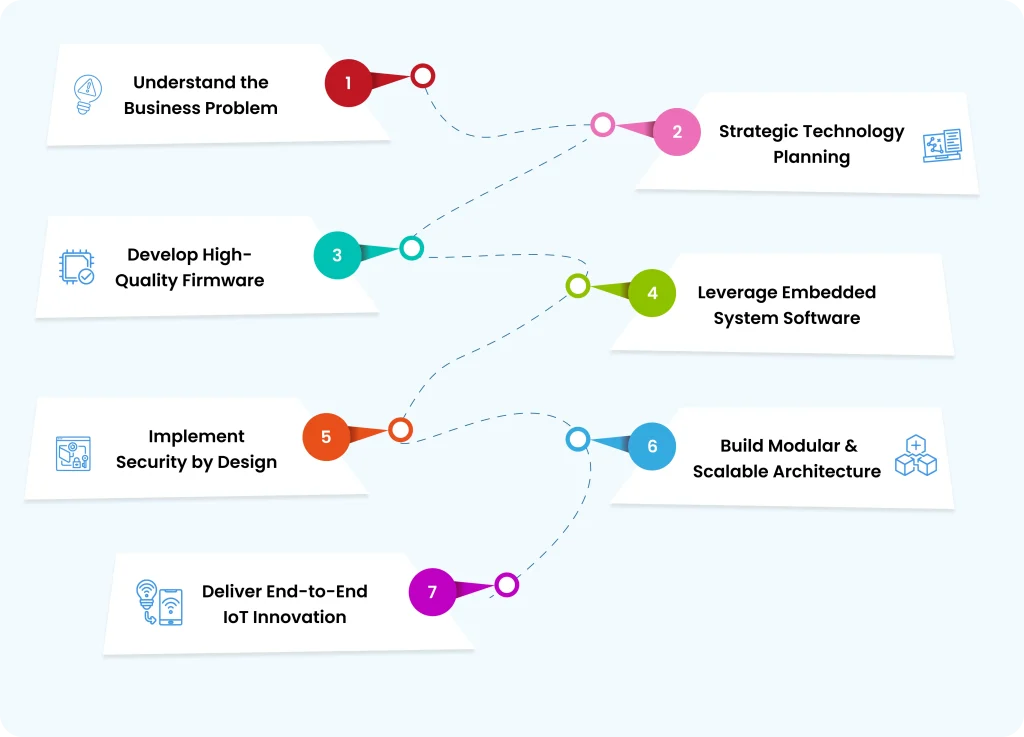
Want to know more our capabilities in IoT Ecosystem?
Features of Cloud Platforms for IoT: Powering the Future of Connected Systems
As the Internet of Things continues to evolve, cloud based IoT platforms have become the backbone of scalable and intelligent connected ecosystems. These platforms provide the infrastructure and tools necessary to connect, manage, and analyze data from millions of IoT devices in real time—turning raw data into actionable insights that drive business transformation.
What Are IoT Cloud Platforms?
IoT cloud platforms are centralized environments where data from edge devices is securely transmitted, processed, stored, and visualized. They serve as a digital bridge between IoT hardware and enterprise software systems, enabling seamless device integration, automation, and analytics.
Some of the Cloud IoT platforms are:
- AWS IoT Core
- Microsoft Azure IoT Hub
- Google Cloud IoT Core
- IBM Watson IoT Platform
- Oracle IoT Cloud Service
Each of these IoT cloud technologies offers a rich set of features tailored to enterprise-grade IoT deployments.
Key Features of Cloud Based IoT Platforms
Device Provisioning and Lifecycle Management
Onboarding thousands of IoT devices securely and efficiently is made possible through automated provisioning tools. Cloud platforms support:
- Bulk registration
- Role-based identity and access management
- Secure authentication (X.509 certificates, OAuth 2.0)
This simplifies deployment while ensuring devices are traceable and manageable throughout their lifecycle.
Real-Time Data Streaming and Processing
Modern IoT cloud platforms are designed for high-velocity data environments. They offer:
- Stream ingestion through protocols like MQTT, AMQP, and HTTP
- Real-time event processing for alerts and automation
- Edge-to-cloud data syncing for reduced latency
This ensures instant responsiveness—critical for use cases like remote monitoring, fleet tracking, or industrial automation.
Custom Analytics Dashboards
Cloud platforms allow developers to create custom IoT analytics dashboards for business intelligence and monitoring. These dashboards can:
- Visualize device performance in real time
- Display sensor data, health metrics, and trends
- Trigger workflows or alerts based on thresholds or anomalies
By leveraging built-in tools like AWS IoT Analytics or Azure Stream Analytics, businesses can turn insights into action without the need for external BI platform
Automated Alerts and Predictive Maintenance
With support for rule engines and machine learning integration, IoT cloud services can send instant alerts when systems detect:
- Faults or anomalies in equipment
- Location deviations in fleets
- Changes in environmental conditions (temperature, humidity, pressure)
This helps businesses transition from reactive to proactive operations.
Firmware Updates and OTA Management
Cloud platforms offer Over-the-Air (OTA) update frameworks that support:
- Secure firmware distribution
- Version control and rollback
- Scheduled or on-demand deployments
This ensures devices remain functional, patched, and secure—without requiring physical access.
Robust Security and Compliance
Security is at the core of every major IoT cloud platform, offering:
- End-to-end encryption of data in transit and at rest
- Fine-grained access policies using IAM
- Compliance with global standards (GDPR, HIPAA, ISO/IEC)
Combined with edge gateway computing, cloud platforms create a multilayered defense for mission-critical IoT applications.
Why Cloud Integration Is Critical for IoT Success
Integrating cloud platforms into your IoT infrastructure provides unmatched benefits:
- Scalability: Handle millions of devices without performance drop-off
- Interoperability: Seamlessly connect with ERP, CRM, and third-party APIs
- Automation: Streamline processes from manufacturing to smart homes
- Resilience: Built-in redundancy and failover options ensure uptime
- Data Intelligence: Drive smarter decisions with machine learning and predictive analytics
A top-tier IoT development company ensures that IoT cloud technologies are perfectly aligned with the client’s goals—whether it’s enhancing customer experience, optimizing logistics, or enabling digital health monitoring.
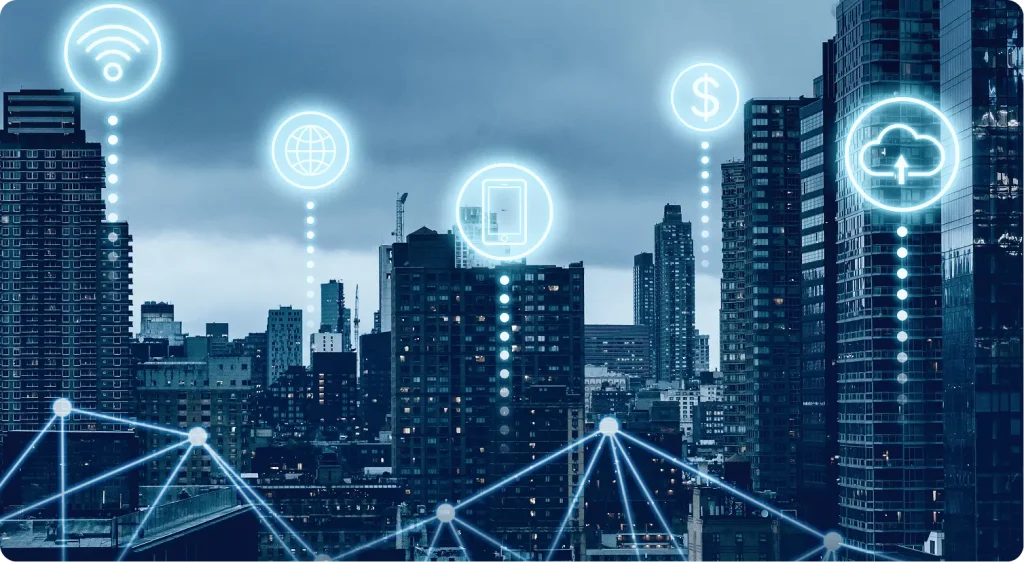
Conclusion
From enhancing agriculture to revolutionizing healthcare, transportation, and homes, custom IoT solutions are unlocking endless possibilities. By working with the best IoT development company, businesses gain access to smart, secure, and scalable solutions tailored to their needs. Whether through edge gateway computing, firmware development services, or IoT applications, the future is connected—and your business should be too.

